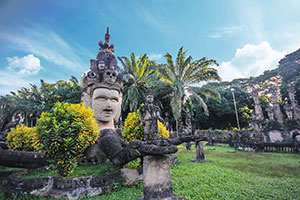ICS Travel Group
Vientiane - Vang Vieng - Luang Prabang by Train Tour
COPE in Vientiane
COPE in an inspiring NGO that provides survivors of unexploded ordnance (UXO) with care and prosthetics.
Kuang Si Falls near Luang Prabang
This three-tiered waterfall, about 29 kilometers south of Luang Prabang, is a favorite side trip for international guests and locals as well.
Mount Phousi Sunset
Located in the heart of the city and 150 m high, Mount Phousi is offering unforgettable views over the temples and houses of Luang Prabang.
Vacation Inclusions
- All applicable local taxes
- English speaking local station guide
- All services as mentioned in your itinerary
- Traditional boat as mentioned in the itinerary
- Accommodation as mentioned in the itinerary
- Drinking water and cold towels during sightseeing
- Fully licensed and insured to international standard
- Ground transportation in private, air-conditioned vehicle
- Multi-lingual 24-hour customer support hotline in all destinations
- Train ticket from Vientiane-Vang Vieng & Vang Vieng-Luang Prabang
- All entrance fees for sightseeing and visits as mentioned in the itinerary
Featured Destinations
Luang Prabang
Luang Prabang
Luang Prabang is the crown jewel of Laos and perhaps the best preserved traditional city in Southeast Asia. The ancient capital of the former Kingdom Lan Xang, it is nestled in the mountains at the confluence of the Mekong and Khan rivers, and is an enchanting and charming destination. The town is adorned with gilded temples on nearly every street corner and saffron robed monks strolling through the quiet city center, giving it a unique charm of bygone days and rich cultural heritage.
|
Destination Guide
|
Vang Vieng
Vang Vieng
A four-hour car ride (or six-hour bus ride) north from Vientiane, this town is a center for karstic geologic formations. Nearly vertical limestone cliffs and spires jut up from the floor of a bucolic river valley that lies about 100 mi/160 km north of the capital. The setting is stunning, but despite its natural beauty, visitors will either love or hate Vang Vieng. For the backpacking fraternity it is simply heaven; for the cultural traveler it is an example of how damaging tourism can be to local culture. The once-sleepy riverside town, perfectly located to break up the journey between Vientiane and Luang Prabang, is overrun with cheap guesthouses, bars and restaurants serving Western food. All the Western comforts and support mechanisms are there—so much for adventure travel. As a result, backpackers settle in Vang Vieng for weeks at a time doing very little but lying around watching TV, getting stoned or tubing down the river. Their presence has also encouraged locals to start dealing drugs, and the town has a reputation for the easy availability of opium and amphetamines. Tubing trips along the Nam Song river are popular, but be aware that the current is very fast in places—inexperienced swimmers have drowned on these trips. Check river conditions locally before signing up for any trip. Several spectacular caverns (some developed, some not) are within a few hours' walk from town.
|
Destination Guide
|
Vientiane
Vientiane
While visiting Vientiane, you’ll delight in the legendary Lao hospitality and the country’s unspoiled beauty. Until recently, Laos was forbidden to foreign travelers. Vientiane, capital of Laos, is busy and hectic in comparison to the rest of the country, but it is quiet compared with any other capital city in Asia. Vientiane, as are the other major city of Laos, is situated on the Mekong River, which forms the lifeline of the country. Vientiane’s major attractions are the serene Buddhist monasteries that dominate the city streets. The city has kept its timeless charm with tree-lined avenues, brightly painted temples and quaint French architecture. Explore Wat Si Saket. Built in 1818, it is the city’s oldest temple and features over 6,800 Buddha images, which are all ritually cleansed at the time of the Lao New Year. Hophrakeo, once the royal temple of Lao monarchy, was built in 1565 and has been used as a museum since 1970. The main structure, which originally housed Prakeo, the Emerald Buddha, now contains some of the finest Buddhist sculpture and artifacts found in the country. Special displays include antique brass drums and palm leaf manuscripts. Also visit the most famous landmark of Vientiane, the soaring stupa Pha That Luang (Royal Stupa), which was constructed in 1566 by King Setthatirat, founder of the Vientiane capital.
|
Destination Guide
|
View Full Itinerary
Valid Date Ranges






